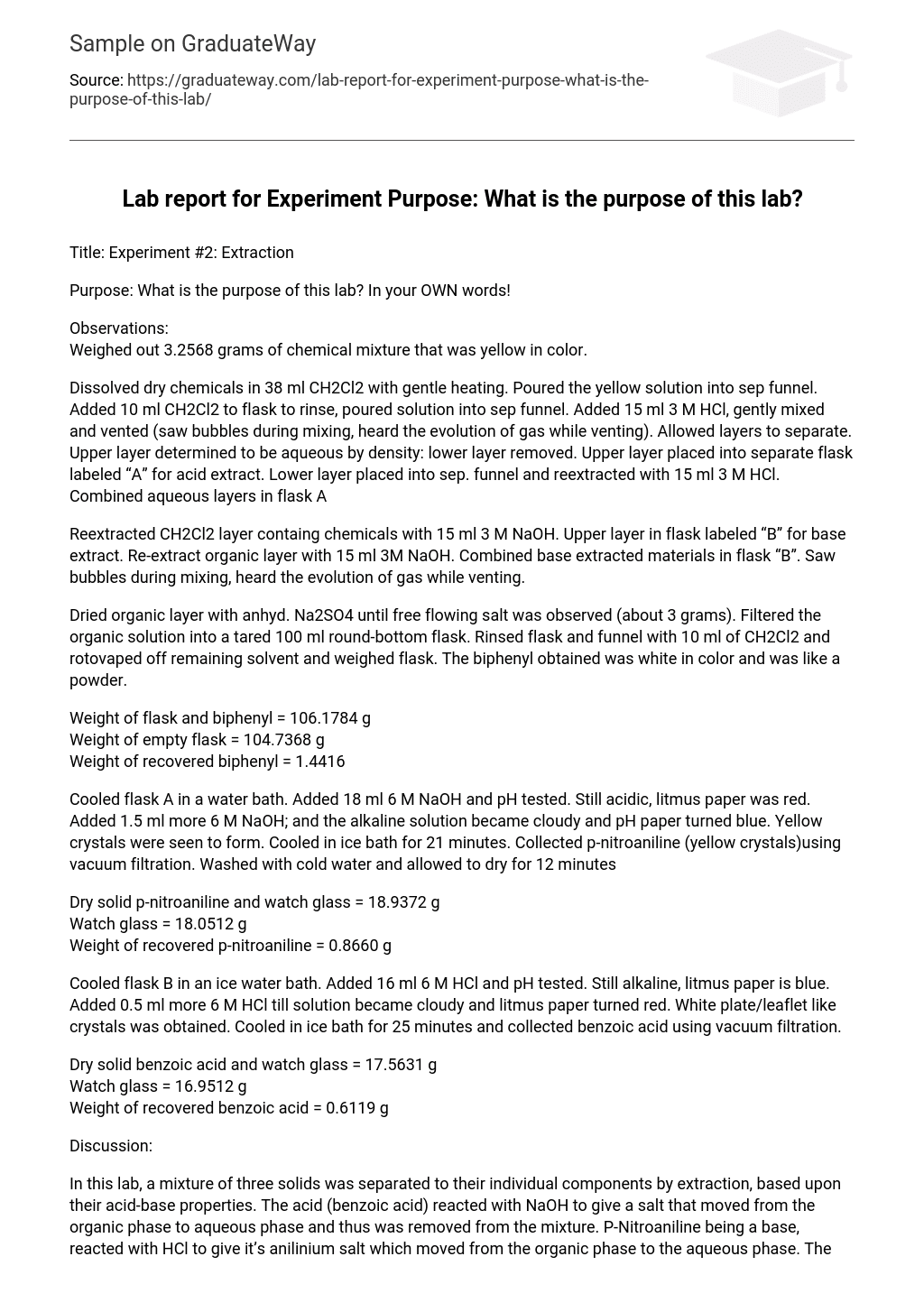Observations
Weighed out 3.2568 grams of chemical mixture that was yellow in color. Dissolved dry chemicals in 38 ml CH2Cl2 with gentle heating. Poured the yellow solution into sep funnel. Added 10 ml CH2Cl2 to flask to rinse, poured solution into sep funnel. Added 15 ml 3 M HCl, gently mixed and vented (saw bubbles during mixing, heard the evolution of gas while venting).
Allowed layers to separate. Upper layer determined to be aqueous by density: lower layer removed. Upper layer placed into separate flask labeled “A” for acid extract. Lower layer placed into sep. funnel and reextracted with 15 ml 3 M HCl. Combined aqueous layers in flask A Reextracted CH2Cl2 layer containg chemicals with 15 ml 3 M NaOH. Upper layer in flask labeled “B” for base extract. Re-extract organic layer with 15 ml 3M NaOH. Combined base extracted materials in flask “B”. Saw bubbles during mixing, heard the evolution of gas while venting.
Dried organic layer with anhyd. Na2SO4 until free flowing salt was observed (about 3 grams). Filtered the organic solution into a tared 100 ml round-bottom flask. Rinsed flask and funnel with 10 ml of CH2Cl2 and rotovaped off remaining solvent and weighed flask. The biphenyl obtained was white in color and was like a powder.
- Weight of flask and biphenyl = 106.1784 g
- Weight of empty flask = 104.7368 g
- Weight of recovered biphenyl = 1.4416
Cooled flask A in a water bath. Added 18 ml 6 M NaOH and pH tested. Still acidic, litmus paper was red. Added 1.5 ml more 6 M NaOH; and the alkaline solution became cloudy and pH paper turned blue. Yellow crystals were seen to form. Cooled in ice bath for 21 minutes. Collected p-nitroaniline (yellow crystals)using vacuum filtration. Washed with cold water and allowed to dry for 12 minutes
- Dry solid p-nitroaniline and watch glass = 18.9372 g
- Watch glass = 18.0512 g
- Weight of recovered p-nitroaniline = 0.8660 g
Cooled flask B in an ice water bath. Added 16 ml 6 M HCl and pH tested. Still alkaline, litmus paper is blue. Added 0.5 ml more 6 M HCl till solution became cloudy and litmus paper turned red. White plate/leaflet like crystals was obtained. Cooled in ice bath for 25 minutes and collected benzoic acid using vacuum filtration.
- Dry solid benzoic acid and watch glass = 17.5631 g
- Watch glass = 16.9512 g
- Weight of recovered benzoic acid = 0.6119 g
Discussion
In this lab, a mixture of three solids was separated to their individual components by extraction, based upon their acid-base properties. The acid (benzoic acid) reacted with NaOH to give a salt that moved from the organic phase to aqueous phase and thus was removed from the mixture. P-Nitroaniline being a base, reacted with HCl to give it’s anilinium salt which moved from the organic phase to the aqueous phase. The component remaining in the organic phase was the neutral biphenyl. Both the acid and base extracts were neutralized to give benzoic acid and p-nitroaniline as solids.
By adding up the weights of the various components without any loss, I should have recovered 3.2568 g of starting material.
- Weight of biphenyl = 1.4416 g
- Weight of p-nitroaniline = 0.8660 g
- Weight of benzoic acid = 0.6119 g
- Total solid recovered = 2.9195 g
- Total recovered mass = 2.9195 g
- Mass of starting material = 3.2568 g
- Total % recovered = (2.9195/3.2568)*100 = 89.6 %
I recovered 89.6% of my starting material. Because of solubility issues (difficulty dissolving all of the starting material) I know that some of the starting material never left the first flask. There was a green film all over the glassware indicating an incomplete transfer.
Conclusion
The implication of “like dissolves like” has implications in daily life from washing dishes and hair all the way to oil spills in the North Atlantic. In this lab exercise we took advantage of the properties of the materials to move them into and out of various phases by using the acid base properties of the compounds. Benzoic acid is soluble in CH2Cl2 until it is deprotonated
and becomes highly water soluble, but neither the acid nor the base changes the solubility of biphenyl. This is not surprising since biphenyl doesn’t contain the kinds of functional groups that would be affected by adding or removing protons.





